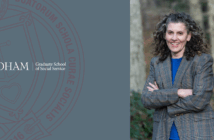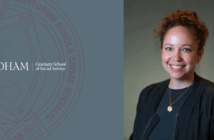The COVID-19 pandemic recovery is looking up, but it’s far from over.
We must not forget how the virus crippled our communities, and highlighted the health disparities and inequities already present within them. And while we continue to battle this deadly, contagious virus, community health is critical.
Enter community health workers (CHWs), experts in addressing the impacts of social determinants of health (SDOH) in community-based settings. They know how their communities live, grow, work, and play — and how all these things affect well-being. If we use their guidance, our community members will have the knowledge necessary to stay healthy.
The problem is, we haven’t used that guidance. We haven’t even given it a chance.
Think about it: have you heard much about CHWs in the U.S. recovery plans? Did you know what CHWs were before this article?
If you answered “no” to either of those questions, Fordham GSS Assistant Professor Rahbel Rahman, Ph.D., wants to find out why.
Community Health Workers in Pakistan
Rahman began her work with CHWs in her home country of Pakistan while working in a free health care hospital. The hospital is located in a low‐income area with an estimated population of 2.5 million people living within a 1‐km radius.
The area, embedded in industry, attracted immigrants from all over the country in need of work. Pakistan has a national community health worker program called the “lady health worker program,” comprised of women who offer maternal and infant health care.
The hospital Rahman worked for was quick to understand that the area also suffered from all types of diseases — tuberculosis and rabies, to name a few of the most prominent — and there needed to be more awareness about those issues. So, as a form of a private initiative, the CHW program was developed for disease promotion and prevention of other health care areas besides maternal and infant health care.
“CHWs are members of the community they serve. They have the lived experience of the community members,” Rahman said. “Community is a fluid term; it could be socioeconomic status. Typically, it’s the neighborhood, but it also constitutes identity — racial, ethnic.”
This is where Rahman’s life changed. She worked with the CHWs, listened to their narratives about health and social care needs in the community, trained them, and set up a structure in which they would succeed. Rahman noted that in listening to CHWs, she recognized a need to merge the experiential knowledge of CHWs with the technical knowledge of the scientific community to address the issues on the ground.
“We [the hospital]realized a disconnect between what our research was asking and what the community needs were,” she said. “CHWs were instrumental in helping us inform the survey development going forward. They knew the communities better than anyone.”
Across the Bridge of Privilege
Rahman grew up privileged, and she recognizes it.
Her home in Karachi, Pakistan is situated in an affluent neighborhood, across a bridge from the hospital where she worked. Every day she’d sit in the back seat of her chauffeured car, accompanied by a security guard, and transform from one life into the next.
“It almost felt like as soon as I went to the hospital, I lost my identity,” she said. “These community health workers exposed me to what life was. I admit I was living in a bubble.”
Rahman went door-to-door with community health workers, visiting households to understand first handedly the conditions in which people lived, and to learn the community best practices in developing health promotion initiatives.
Rahman added that for someone with her privilege, “A woman cannot walk on the streets of Karachi. These community health workers protected me. They were there. And I really tried to assimilate as best as I could into the community and understand the community needs, listen to their narratives, reflect on my privileges, and see where I could situate myself in relation to the community.”
Rahman said she was shocked by what she saw when she went for household visits.
“It was extreme poverty,” she said. “You do see poverty on the streets in Pakistan, but growing up seeing street children and beggars on the street almost results in a state of numbness. You don’t hear the narratives; you don’t go in their homes and feel what they’re feeling. The compassion and humility that I developed in this journey that CHWs took me on has been a lifelong experience for me.”
Pairing Experience with Technicality
Rahman cherished her time with the Pakistan community health workers, but she wanted to combine the experiential knowledge they taught her with a more scientific and technical skillset. So, once the hospital’s CHW program was set up and running smoothly, she applied for her postgraduate degree.
Rahman then received a prestigious national scholarship, which allowed her to pursue her M.S.W. and Ph.D. studies at Columbia University’s School of Social Work.
“The first thing I did when I came to Columbia University was contact professors who worked with community health workers,” she said.
Her time at Columbia put her in touch with her mentor, Rogério Meireles Pinto, who was interested in community health workers in Brazil at the time. Rahman wanted to know how CHWs were a part of the family health team in Brazil. Her publications stemmed from her dissertation, which focused on the ways in which CHWs work with physicians and nurses within interprofessional health care teams to offer integrated care to patients.
Rahman traveled to Brazil and spoke with CHWs there. Her recent publication was accepted in the Journal of General Internal Medicine which examines how patients evaluate CHWs ability to practice narrative medicine. Currently, there is a focus on teaching doctors and nurses how to better show empathy, compassion, and humility through the practice within medical school curricula.
“The reality is, CHWs do that,” Rahman said. “They listen to narratives, they process it — that’s what they do. Why are we not learning from them? What’s happening that we’re not catching? Why can’t we learn from them?”
Misunderstanding the CHW Role
The answer to that question, Rahman said, is that CHWs are not doctors. Or nurses. They did not go to medical school, take the exams, or get the training. And this lack of experience and knowledge can result in a lack of respect from the rest of the medical community.
“Just like the physician/nurse power dynamic is a problem,” Rahman said, “the physician/CHW power dynamic is even worse.”
The truth is, CHWs know the people. They live beside them, and with them. In the U.S., CHWs help their neighbors by supplying them with what they need. This can be material objects, such as diapers and cribs, or other modes of assistance, such as helping people obtain mental health screenings, or identifying child abuse and domestic abuse in homes.
But CHWs aren’t well integrated in the healthcare system. They aren’t listened to; they’re ignored, even in the face of a pandemic — one that is destroying communities in droves.
In addition, the compensation for CHWs — despite all the good they do for communities — is an ongoing issue for the position as well. Many CHWs are limited to uncertain, part-time, un-benefited schedules. This, coupled with the emotional toll they bear, can make it difficult to keep showing up for their communities.
Arrival at Fordham and Exemplifying CHW Importance
Rahman arrived at Fordham just three years ago, determined to exemplify the importance of CHWs. She realized through her research that, in the U.S., CHWs are trained in home visiting programs, but their roles don’t seem as well-defined as those whose job titles were “Home Visitors.”
So, she teamed up with fellow GSS assistant professor Abby Ross, Ph.D., who conducted extensive research in the field of home visiting. Rahman and Ross, through funding from the FRDF grant, conducted a survey consisting of 75 CHWs and 75 home visitors in New York. The goal was to understand individual and organizational level predictors to job performance, well-being, and ability to deliver evidence-based services.
In the midst of their research, Rahman noticed a gap in the CHW conversation — managerial support.
An important point to note: CHWs are expected to be supervised by either an RN or a licensed master of social work. Rahman and Ross conducted focus groups with executive directors and managers overseeing these CHWs, and merged the results with the earlier survey data to highlight the importance of these positions during COVID-19 recovery. Her recent publication, published in Health Promotion International, speaks to this.
“We tried to really exemplify the importance of CHWs,” Rahman said. “They do mental health screening; advocate for communities; screen for disease prevention; all in friendly, layman terms. Why are we not incorporating them in our COVID-19 plan? It seems crazy that there is so much focus from state and city to engage communities, but we’re not engaging CHW as frontline responders.”
She is also currently exploring how race dynamics play a role with CHWs supervision.
“A lot of work needs to be done with the concept of looking at the reality [of the situation],” she said. “The majority of social workers are white women. The next step is to explore the power dynamics of white women in supervisory roles over women of color.”
The Bridge to the Community
The symbolism is so strong it’s almost cliché: at the start of her career, Rahman had to, literally, cross a bridge into the community she worked for to advocate for local CHWs in Pakistan. Doesn’t it make sense that CHWs are the metaphorical — but oh so vital — bridges into communities, wherever those communities may be?
But when budget cuts are made, Rahman said, CHWs are among the first to go — and it can’t be that way. That’s why she has made it her mission to spotlight these crucial, yet under-appreciated, workers. They are the medical field’s connection to the community. They bridge the experiential gaps in our knowledge.
“[The COVID-19 pandemic has shown] the importance of community ownership,” Rahman said. “CHWs can help mobilize communities to take ownership of their own health issues.”
So, the narrative has to switch. Instead of wondering, how can we support CHWs in the medical field, we must ask, how can we not?


